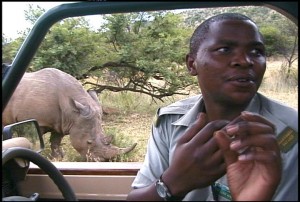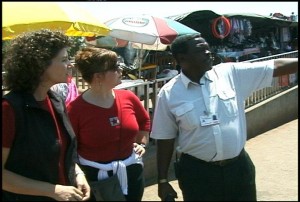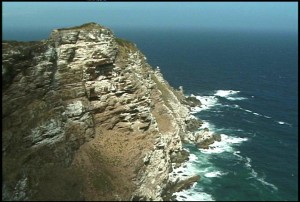(Editor’s note: This article was written by Cindy McGlynn a few years ago when we filmed in South Africa. I felt it was well worth reprising as it is still valid and her enthusiasm for the country is hard to match.)
It’s hard to describe the way you feel when your plane touches ground in South Africa. If you’re like most people, you’ve probably got a lifetime of anticipation shaping your thoughts. How beautiful is Capetown? Are there really penguins on the Cape of Good Hope? Will you see lions trekking across the savannah?
The answers to these questions are as follows: Breathtakingly beautiful and yes, yes, yes!
First things first: what everyone really wants to do, is to go on safari. And there are several different ways to do it. For the real wild stuff, go to a private game reserve like Sabi Sabi. It’s just on the edge of Kruger National Park and privately owned. Intrepid rangers and trackers can take you off-road into the bumpy veld, searching for animals.
We met up with Steve Topham, the bush manager of Sabi Sabi game reserve and got taken on the ride of our lives! Our very first time out at Sabi Sabi, we actually saw a cheetah stalking an impala.
“She’ll get to probably about fifty yards away from those impala and then she’ll accelerate to an enormous speed and then chase them,” said Steve – which is exactly what the cheetah did.
“Anything up 80-90 kilometres an hour. And whilst chasing, she actually targets on one specific animal.”

Close Encounters at Pilanesburg National Park!
We caught up the cheetah after the chase and waited while the sleek, narrow cat caught her breath before eating. It was a difficult scene to watch – more difficult when we realized the small impala’s mother was watching too.
“Yeah, the mother’s watching,” says Topham, “We make the biggest mistake of transferring our emotions, human emotions across to that of the animals. Yeah, its mother is watching – and that happens. And, unfortunately, that’s the bush. Sad but true, but that’s the bush.”
If bush is your thing, you’ll want to make sure you go on a walking safari. We learned the ins and outs of bush lore from ranger Zane, saw some delightful warthogs up close and felt the exhilarating adrenalin rush of walking across the African veld. Before checking out of Sabi Sabi, we’d seen all the big five and started on what we called the “little five…” – warthogs, kudu, baboons and the like.
There are other ways to go on safari too. If the private game lodges are too rich for your blood, (upwards from $600/night) check out the national parks. Kruger is the biggest and most well known, but equally exciting is Pilanesburg National Park and game reserve – just 10 minutes outside of Sun City and about two hours from Johannesburg.
“This park was established in 1979,” our ranger Moses told us. “The same time as Sun City. And it’s situated on an extinct volcanic crater that erupted one point three million years ago.”
Pilanesburg is different from Sabi Sabi in at least a few ways. The landscape is lush and more rolling than the traditional dusty savannah of Sabi and the Kruger area. It’s also much cheaper – you pay about $10 per person to enter. Pilanesburg a feels tamer because you don’t go off the road – but that doesn’t mean you see fewer animals. We had close encounters with the endangered and rare white rhino and also saw giraffe, wildebeest, zebras and ostriches.
There’s just one thing to remember – don’t step outside the vehicle. But no worries – you can still get great photos without leaving your seat!
The safari experience is nothing short of stunning and a major part of any trip to South Africa.

But if culture is your thing and you want to really take the pulse of the new South Africa, you head to Soweto.
Soweto But if culture is your thing and you want to really take the pulse of the new South Africa, you head to Soweto. Home to revolutionaries, including Nelson Mandela, through the apartheid years, Soweto has a population of about 6 million black South Africans, including Archbishop Desmond Tutu.
Conditions vary from well cared for middle-class dwellings to shanty towns – and you’ll see it all on your driving tour through the sprawling township with a local tour guide. Many of the locals are clearly struggling for a better life, but Soweto is very much alive.
“I think that in ten years time this will be entirely changed place, Soweto,” said our guide, Stanley Mbense. “It will be completely changed. You will see the suburbs that we are going to. So you can see that people are heading for the right thing and the good thing for this country.”
Your township tour will take you to Regina Mundi Roman Catholic church – famous and revered for opening its doors to political organizations and worshipers when it was dangerous to do so. You’ll see bullet holes in the ceiling and a mural of Nelson Mandela and Desmond Tutu – who held the famous Reconciliation Trials here in the 1990s – at the back.
“There’s a bullet hole right on top there,” said Mbense, pointing at the plain white buttresses flanking the ceiling. “It’s not the only one. These windows were replaced too.”
South Africa is big by anybody’s standards – about the same size as Ontario and amazingly diverse. Blyde River Canyon in the north has breathtaking scenery. Kruger Park has the low veld savannah that many people picture when they imagine Africa.
Then, there’s the stunning beauty of Cape Town.

stunning beauty of Cape Town.
This cosmopolitan city is flanked on one side by Table Mountain and on the other, by the sea. Locals are unequivocal in their praise of the beautiful city.
“Cape Town is the place to be,” said tour guide Harry Van Nimvegan, “We have a Mediterranean climate with winter rainfall in June and July. And we have long hot summers. Reallyhot, dry, glorious summers.”
We stayed down in the lively waterfront at the Table Bay Hotel – right at the mouth of Cape Town’s working harbour and in the shadow of Table Mountain. Talk about location – and it’s not just for tourists, lots of locals hang out here too.
One of the nicest parts of town is the colourful Muslim Quarter, with its brightly painted houses and cobblestone streets. You can visit Green Market – filled to the brim with curios.
For the best view of Cape Town, there’s only one way to go, and that’s up!
“The indigenous people refer to Table Mountain as the ‘Mountain In The Sea,'” said our guide.
“Several thousands of years ago, the water level was approximately three hundred metres higher than it is today. So Table Mountain literally would have looked like a mountain sticking out of the ocean.”
The view is stunning. If you look out across the water you can see the stark flatness of Robben Island. The former prison island is infamous for incarcerating Nelson Mandela for the better part of the 25 years he spent in jail. Dozens of other political prisoners spent years here and today it’s a national heritage site with powerful displays and a fascinating tour.
To the south, your eyes dance down the Cape of Good Hope
The long narrow peninsula lashing out into the Atlantic. A tour of the Cape, with its mile upon mile of rocky, coastline and over a thousand species of indigenous plants is a must. You’ll see seals, penguins, ostriches and easily some of the most breath-taking vistas any coast anywhere in the world could offer.
Not long after visiting the Cape, we headed home. But what better place to end our journey? Right on the southwestern tip of one of the most fascinating countries in the world – South Africa.


